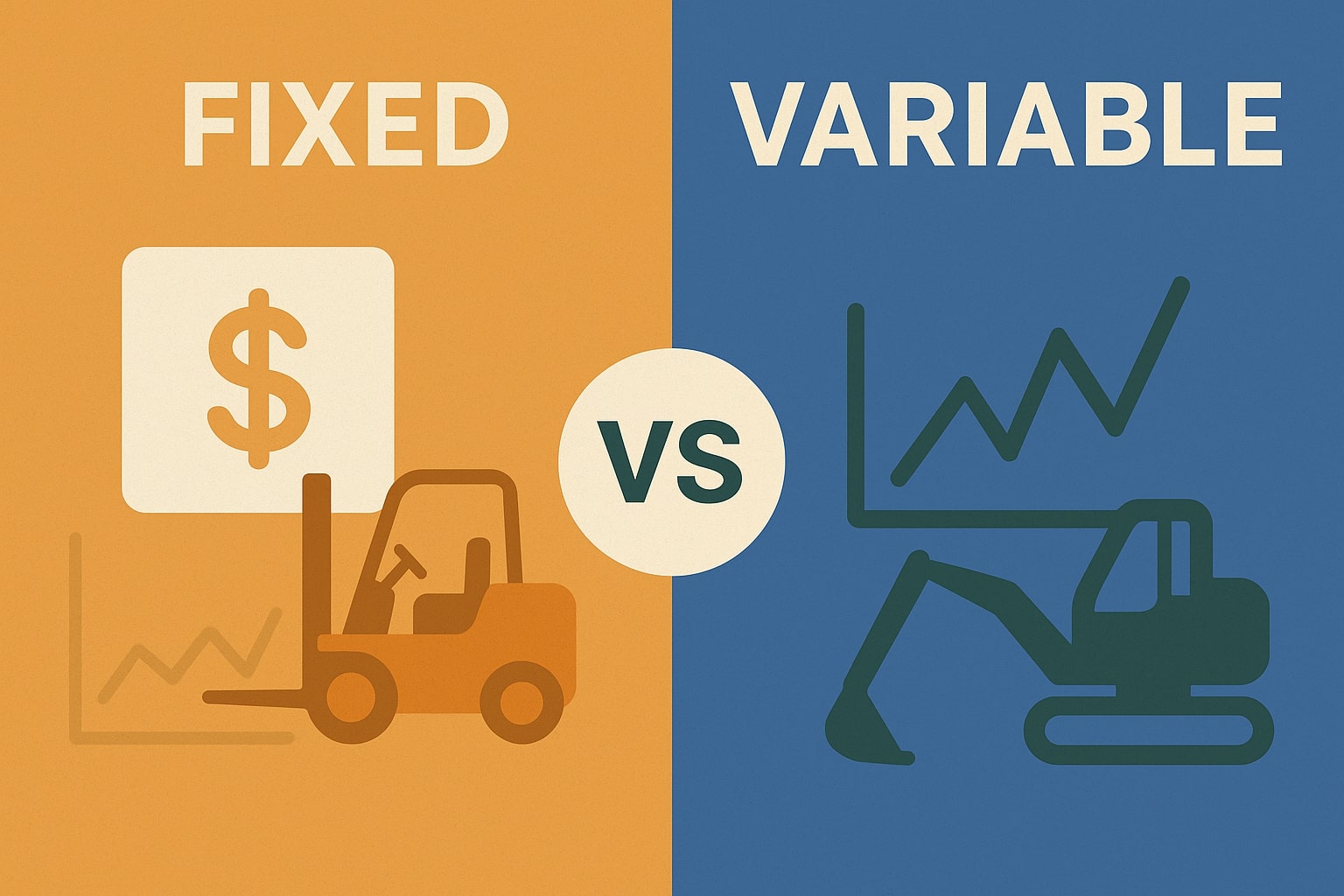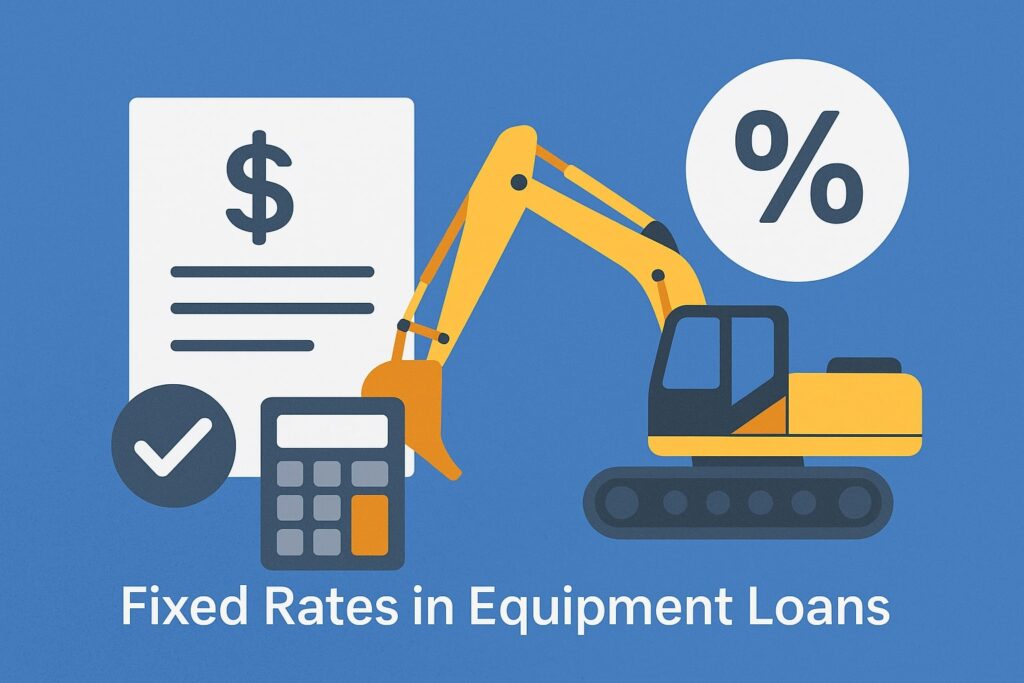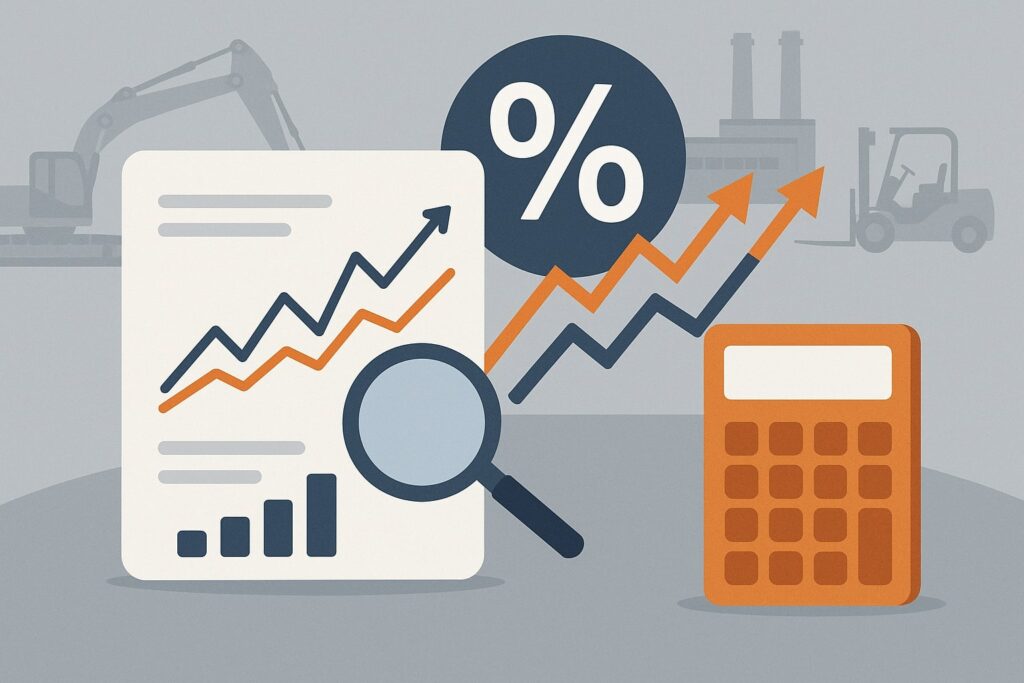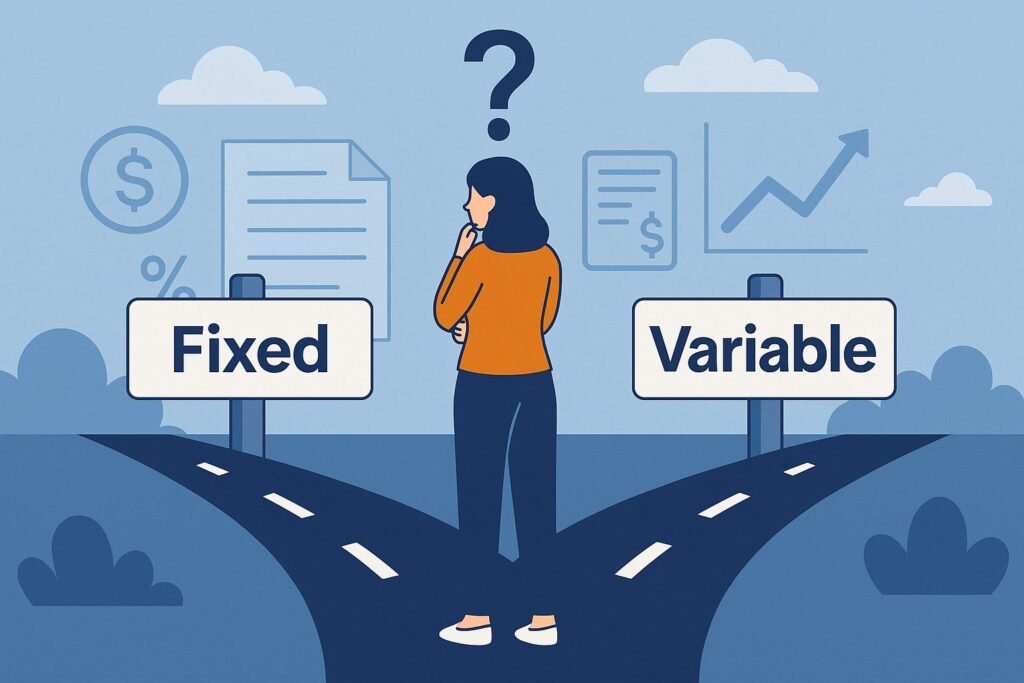
Understanding Fixed vs Variable Rates in Equipment Loans
Equipment loans help U.S. businesses acquire machinery, vehicles, technology, medical devices, POS systems, and other productive assets without draining cash reserves. In a typical structure, the lender advances most of the purchase price—often 80% to 100%—and the equipment serves as collateral.
You repay over a fixed term, commonly 24 to 84 months, through predictable installments or payments tied to a rate index. Because the asset secures the note, equipment loans can be faster to obtain than unsecured credit and may offer competitive pricing compared to standard term loans or credit cards.
For small businesses, the draw of equipment loans is simple: you match the cost of the asset with the revenue it helps generate, which preserves working capital for payroll, inventory, and marketing.
In the U.S., equipment loans come with two primary pricing choices: fixed rates and variable rates. Understanding fixed vs variable rates in equipment loans is the core of smart financing, because your interest structure affects monthly affordability, total cost, and risk if the rate environment changes.
Fixed rates lock a constant APR for the entire term, delivering certainty. Variable rates float with a benchmark like the Prime Rate, SOFR, or a lender’s base rate, meaning your payment can rise or fall as markets move.
Beyond rate type, lenders evaluate time in business, credit profile, cash flow, equipment type, residual value, and down payment. They also consider fees such as origination, documentation, UCC filing, and prepayment penalties.
The goal of this guide is to help U.S. owners compare fixed vs variable rates in equipment loans with confidence, so they choose the structure that supports profitability across real-world cycles.
Fixed Rates in Equipment Loans: Definition, Mechanics, Pros and Cons

A fixed-rate equipment loan charges the same interest rate for the full term, so your principal and interest schedule is set on day one. Lenders usually quote a fixed APR or a note rate plus fees.
Amortization is straightforward: each payment includes interest on the remaining balance and a principal reduction, and your monthly obligation doesn’t change. This predictability makes budgeting easier, stabilizes unit economics, and simplifies forecasting KPIs like debt-service coverage ratio (DSCR) and EBITDA margins.
In many U.S. small-business contexts, fixed rates are paired with level payments, though some lenders also offer seasonal fixed structures for industries with predictable cycles.
Choosing fixed vs variable rates in equipment loans often starts with risk tolerance. Fixed rates remove interest-rate volatility risk. You won’t benefit if market rates fall, but you’re protected if rates climb.
Fixed rates can be slightly higher on day one than comparable variable quotes because the lender is assuming rate risk for the term. Pros include payment certainty, easier cash flow planning, and protection during rising-rate periods.
Cons include potentially higher initial pricing, prepayment penalties such as yield maintenance, and the opportunity cost of not participating in future rate cuts.
For assets with long useful lives—like CNC machines or medical imaging—many U.S. operators prefer fixed rates to align stable costs with long-term revenue streams.
When Fixed Rates Make Sense for your Business
Fixed vs variable rates in equipment loans should be matched to your revenue stability. Fixed rates shine when your margins are tight and your customers expect steady pricing.
If your business sells long-term contracts or subscriptions—think managed IT services, industrial maintenance, or healthcare practices with payer schedules—predictable payments de-risk your model.
Fixed rates are also compelling when you’re close to bank or SBA DSCR covenants, since stable payments reduce the chance of covenant pressure as markets move. If your equipment is mission-critical and downtime is expensive, a fixed rate can help you budget maintenance and replacement reserves without juggling a payment spike.
A fixed rate may also be better when the Federal Reserve is signaling higher rates, or when inflation is sticky and financing costs could rise. If you plan to hold the asset through the full term and you’re not expecting to refinance quickly, locking the rate can reduce uncertainty.
In addition, fixed-rate equipment loans help new businesses that are building back office discipline. Controllers can set monthly accruals, project cash burn more accurately, and avoid surprises.
For U.S. owners who need clean, consistent financials for audits, bonding, or lender reviews, fixed rates simplify reporting and can support valuation by smoothing free cash flow. Ultimately, if certainty beats flexibility in your decision matrix, fixed rates are the safer selection.
Common Misconceptions about Fixed Rates
A recurring myth is that fixed rates are always more expensive than variable rates. In reality, fixed vs variable rates in equipment loans depends on market curves, credit strength, and term length.
Shorter-term fixed loans can sometimes price below variable offers if lenders compete for high-quality borrowers or if the yield curve is flat or inverted. Another misconception is that fixed loans can’t be prepaid.
Many can—subject to clearly stated penalties. If you expect to refinance after a year or two, negotiate a declining prepayment schedule or partial prepayment rights at closing.
Some owners also believe choosing a fixed rate eliminates all risk. While rate risk is contained, you still face operational risk, technology obsolescence, and residual value uncertainty. If the equipment’s productivity underperforms, a fixed rate won’t rescue unit economics.
Others assume fixed rates block access to working-capital flexibility. In practice, you can combine a fixed-rate equipment loan with a revolving line for seasonality. Finally, a misconception is that fixed rates are less “sophisticated.”
In truth, many treasury-savvy companies prefer fixed structures for core, long-lived assets and then use separate variable facilities for opportunistic spending. The right mix should reflect the productive life of the asset and your risk appetite, not a one-size-fits-all belief.
Variable Rates in Equipment Loans: Definition, Mechanics, Pros and Cons

A variable-rate equipment loan ties your interest to a benchmark plus a spread—commonly Prime + X% or SOFR + X bps—so your payment adjusts as the index moves. Most lenders reset monthly or quarterly.
Early in the term, when balances are higher, payment changes are more noticeable. Variable rates can start below comparable fixed rates because you, not the lender, absorb the risk of rate increases.
For U.S. businesses with strong, flexible cash flow, variable pricing can lower average borrowing costs if rates trend down or remain stable.
The fixed vs variable rates in equipment loans decision often hinges on your forecasting confidence. Pros of variable rates include potentially lower initial cost, benefit from rate declines, and flexibility to refinance or pay down faster without heavy penalties.
Cons include exposure to interest-rate spikes, budgeting complexity, and the possibility that payments rise when revenue softens. Variable loans also require disciplined monitoring: a 100-basis-point move matters to DSCR and covenant headroom.
If your industry swings with commodity prices or consumer demand, pair variable borrowing with strong liquidity buffers. When used intentionally—with hedges or caps—variable rates can be a strategic tool, particularly for assets you expect to refinance soon or retire early.
When Variable Rates Make Sense for your Business
Variables can be smart when you have robust margins, diversified revenue, and the ability to pass through cost changes quickly.
Businesses with dynamic pricing—like construction services using cost-plus contracts, logistics firms with fuel surcharges, or specialty clinics with out-of-network pricing—can absorb modest payment variability.
If you plan a short holding period because technology advances rapidly—think robotics, software-driven equipment, or high-cycle POS terminals—variable rates may reduce your average cost before you upgrade.
Variable also fits when your capital structure already includes fixed-rate debt. Blending fixed vs variable rates in equipment loans creates a natural hedge, so you’re not 100% exposed to either scenario.
If macro indicators suggest easing policy or stable inflation, a variable structure gives you participation in declines. Finally, variable loans align with borrowers who actively manage treasury.
If you maintain rolling 13-week cash forecasts, sensitivity scenarios, and board-approved risk limits, you can capture the upside while controlling downside through liquidity, caps, or accelerated amortization.
Managing Interest Rate Risk with Variable-rate Equipment Loans
Interest rate risk doesn’t have to be a guess. Treat variable debt as a managed exposure. First, set a risk budget: define the maximum payment increase you can absorb without breaching DSCR or compressing margins below target.
Build scenarios for +100 bps, +200 bps, and +300 bps. Second, maintain liquidity buffers—such as an undrawn revolver or cash reserve—sized to cover at least six months of a worst-case payment delta.
Third, negotiate guardrails: ask for quarterly rather than monthly resets, consider a payment cap, or add a right to convert to fixed at predefined spreads.
Hedging tools can further tame variability. Interest rate caps set a maximum benchmark rate for a premium; collars pair a cap with a floor to reduce cost; and swaps can convert a floating note into synthetic fixed.
Even simple tactics help: schedule principal curtailments during strong months, or accelerate prepayments when rates drop. Communicate with your lender early if stress looms—modifications are easier before a covenant pinch.
In short, variable loans reward active management. With planning, you can capture the advantages of variable pricing while avoiding shocks that derail cash flow.
Fixed vs variable Rates in Equipment Loans: Side-by-Side Comparison
When evaluating fixed vs variable rates in equipment loans, map the decision to cash flow, horizon, and risk. Fixed loans provide certainty and are ideal for long-lived assets and thin margins.
Variable loans offer flexibility and can be cheaper if rates fall or if you expect to refinance soon. Consider the following practical contrasts: budgeting—fixed is stable; variable requires monitoring. Initial price—variable often starts lower; fixed bakes in insurance against hikes.
Prepayment—variable is usually more flexible; fixed may include penalties but can be negotiated. Covenant comfort—fixed helps preserve DSCR predictability; variable can strain ratios in a rising-rate period.
Total cost matters, but so does volatility. Suppose two offers: 7.9% fixed for 60 months vs Prime + 1.50% resetting monthly. If Prime is currently 8.50%, your day-one variable rate is 10.00%. Fixed clearly wins now.
But imagine a different moment where SOFR is 3.00% and your spread is 2.75% for an initial 5.75%—variable looks attractive if you expect easing or plan a two-year refinance. Always model plausible rate paths, prepayment options, and your operational cycle.
The right answer is often a blend: fix core, float opportunistic. That blend lets you meet near-term opportunities without over-insuring against risks you don’t carry.
Total Cost of Ownership and Break-even Analysis
A practical way to compare fixed vs variable rates in equipment loans is to compute “break-even rate paths.” Start with your variable offer’s index plus spread. Build scenarios where the index rises or falls 50 to 300 basis points over your expected holding period.
Calculate cumulative interest in each path and compare it to the fixed loan’s total. The break-even is the trajectory at which both options cost the same. If your most likely scenario is below the break-even, the variable may win; if above, fixed offers value.
Next, factor prepayment. If you are 70% likely to refinance in 24–36 months due to growth or a tech refresh, weight the totals accordingly. Also consider tax depreciation, Section 179 expensing, and bonus depreciation effects on after-tax cost. A lower rate isn’t always the winner if one structure accelerates deductions that improve cash flow timing.
Finally, examine the residual value. If you plan to sell the asset early, a shorter, variable structure can match your true economic life. Use conservative assumptions and make the analysis part of your credit memo, so management and lenders see a disciplined approach to rate risk.
Market Benchmarks and How Lenders Price Equipment Loans in the U.S.
U.S. equipment loans typically price off widely watched benchmarks. For banks and many independent lenders, the Prime Rate is a common reference, especially for smaller balances.
For more sophisticated or larger credits, SOFR (Secured Overnight Financing Rate) is now the dominant index, replacing LIBOR in U.S. markets. Lenders then add a credit spread that reflects your risk: financial performance, collateral quality, and term.
For fixed-rate loans, lenders effectively convert a floating curve into a fixed yield using the swap market or their own cost of funds, then add a margin. In every case, spread discipline is key: stronger cash flow, better collateral, and longer tenure can reduce the spread.
When comparing fixed vs variable rates in equipment loans, ask the lender to disclose the index, reset frequency, and the exact spread. Clarify if there’s an interest-rate floor (e.g., “SOFR cannot float below 1.00%”).
Understand fees that behave like rate: documentation charges, interim interest from funding date to first payment, and prepayment considerations. For vendor programs—like equipment manufacturers that partner with a financing arm—promotional fixed rates may be subsidized to accelerate sales.
Those can be attractive, but review total economics, including any required service contracts or higher asset pricing. Knowing how lenders build rates empowers you to negotiate from first principles, not just accept the first quote.
Underwriting Factors that Drive your Rate
Several variables shape pricing for equipment loans in the U.S., regardless of whether you choose fixed vs variable rates in equipment loans. Lenders focus on time in business, profitability trends, cash flow stability, leverage, and liquidity.
They analyze DSCR—usually aiming for at least 1.20x to 1.35x—plus global debt obligations if you own multiple entities. Personal credit scores still matter for small and mid-sized companies; stronger personal credit can reduce rates and widen approval options. Industry risk is important—cyclical sectors may face higher spreads.
Collateral matters too. New equipment with strong resale markets, like yellow iron or medical devices, often earns better terms. Specialized or rapidly obsolescing assets can push pricing up or shorten terms. A meaningful down payment—10% to 20%—lowers risk and can shave spreads. Guarantees, cross-collateral, and additional security can also help.
Documentation quality influences the timeline and cost: clean financial statements, bank statements, tax returns, a robust equipment quote, and proof of insurance speed closing and demonstrate lender-friendly governance. Ultimately, present a complete, accurate package and you’ll improve both approvals and rates.
Choosing Between Fixed and Variable: A Decision Framework

To decide between fixed vs variable rates in equipment loans, apply a simple framework: horizon, volatility, flexibility. Horizon asks how long you’ll hold the asset and the loan.
If the probable horizon is shorter than the full term, the variable may reduce cost—unless rate risk is extreme. Volatility evaluates how sensitive your business is to payment swings. If a 5%–10% payment change harms DSCR or gross margin, fixed is safer.
Flexibility measures strategic options you want to preserve. If you anticipate refinancing, selling the asset, or consolidating debt after a milestone, a variable loan with low or no prepay penalties could be ideal.
Add a fourth lens: blended structure. You can take a fixed-rate core term loan for the base purchase and a smaller variable tranche for upgrades or accessories. That combination creates diversification across rate scenarios.
Finally, document the choice. In your credit memo, include your base case, upside and downside rate paths, and the break-even analysis. That disciplined approach helps owners, CFOs, and boards understand why a fixed or variable structure best serves strategy, rather than defaulting to habit or hunch.
Hedging and Hybrid Options (Rate Caps, Swaps, Fixed-to-Float)
Hedging lets you keep the flexibility of variable debt while controlling risk. A rate cap sets a ceiling on the benchmark; you pay a one-time premium, and if the index breaches the cap, the hedge offsets the excess.
A collar combines a cap and a floor to reduce premium cost. An interest rate swap synthetically converts floating payments to fixed by exchanging cash flows based on a notional amount.
Swaps require documentation and typically suit larger loans, but many middle-market borrowers use them effectively. Some lenders also offer a fixed-to-float conversion option or a float-to-fixed right at predetermined spreads, letting you pivot as markets change.
When considering fixed vs variable rates in equipment loans, ask your lender about these structures at the term sheet stage. Price transparency matters: request quotes for cap levels, floor terms, and conversion spreads.
If you’re a smaller borrower, you can still implement “operational hedges”: maintain a cash cushion, schedule principal curtailments, and set triggers to lock in fixed if the index rises to a threshold.
The best hedge is the one you’ll actually manage—choose tools that fit your scale and treasury sophistication rather than chasing complexity for its own sake.
Compliance, Taxes, and Accounting Considerations in the U.S.
Your choice between fixed vs variable rates in equipment loans doesn’t change core U.S. tax rules, but it can affect timing and financial statement presentation. Many businesses leverage Section 179 expense and bonus depreciation to deduct a substantial portion of equipment costs in the year placed in service, subject to limits and taxable income.
Confirm with your CPA how expenses interact with state rules. From an accounting perspective, equipment loans appear as debt on the balance sheet with interest expense recognized over time. Payments reduce principal and record interest, while the asset is capitalized and depreciated.
Compliance items include UCC-1 filings, insurance requirements listing the lender as loss payee, and periodic financial reporting covenants. If you use a variable rate, confirm how interest-rate changes affect covenant calculations.
Some lenders use trailing-twelve-month DSCR; others test quarterly. Public-sector or healthcare borrowers should also confirm license and payer compliance for financed equipment.
If you consider hedges like swaps, work with advisors to document hedge accounting if relevant. Ultimately, align your tax strategy, accounting policy, and lending documents so they reinforce—not contradict—your economic goals for the asset.
Application Checklist and Negotiation Tips
A crisp package improves approval speed and pricing, whether you favor fixed vs variable rates in equipment loans.
Prepare:
(1) last two to three years of business tax returns and financial statements;
(2) YTD P&L and balance sheet;
(3) recent bank statements;
(4) A/R and A/P aging;
(5) equipment quote with serials, warranty, and delivery timelines;
(6) insurance binder;
(7) ownership and entity documents; and
(8) a short credit memo explaining the business case, ROI, and repayment source. Include DSCR calculations and, if choosing variables, your risk controls.
When negotiating, ask for multiple structures: a fixed quote, a variable quote, and a blended option. Request clarity on index, reset frequency, and floors. Push for a declining prepayment schedule or no-penalty principal curtailments up to a percentage each year.
Compare “all-in” APR, not just note rate—include fees, interim interest, and documentation costs. If you have competing offers, share verifiable terms and invite the lender to match on spread or fees.
Finally, time funding with delivery to minimize interim interest, and confirm any promotional rates are not offset by higher equipment pricing. A disciplined, transparent approach often produces better terms and a partnership mindset with the lender.
FAQs
Q.1: What is the simplest way to choose between fixed vs variable rates in equipment loans?
Answer: Start with cash-flow sensitivity. If a moderate payment increase would stress operations, lean fixed. If you have strong buffers and expect to refinance soon, variables may reduce cost. Blend when in doubt.
Q.2: Do variable loans always start cheaper?
Answer: Often, but not always. Market curves, spreads, and promotions can make fixed prices comparable or better. Ask for both quotes and model realistic rate paths.
Q.3: Can I switch from variable to fixed later?
Answer: Sometimes. Negotiate a conversion right with a defined spread. If not available, you may refinance—or use a hedge like a swap or cap.
Q.4: Are fixed rates safer?
Answer: They are safer for interest-rate risk, but not a cure-all. Operational, technology, and residual risks remain. Choose the structure that matches asset life and revenue durability.
Q.5: How do SBA loans fit in?
Answer: SBA 7(a) and 504 can finance equipment with competitive pricing and longer terms. 7(a) is often variable; 504 debentures are fixed. Compare fees, timing, and collateral rules.
Q.6: What should I watch in the loan agreement?
Answer: Index and spread, floors, reset frequency, prepayment terms, covenants, collateral description, and insurance requirements. Clarify any fees that mimic the rate.
Q.7: Can I deduct interest?
Answer: Generally yes, for business loans, subject to IRS limitations and your tax situation. Confirm with your CPA, especially if you use Section 179 or bonus depreciation.
Q.8: Is leasing different from an equipment loan?
Answer: Yes. Leases may be operating or finance types with different end-of-term options. Compare total cost, tax treatment, and flexibility before deciding.
Q.9: What benchmarks matter in the U.S.?
Answer: Prime and SOFR are common. Understand which index your lender uses, how often it resets, and whether there’s a floor.
Q.10: How much down payment helps pricing?
Answer: Putting 10%–20% down often improves approval odds and may reduce spreads. It also lowers monthly payments and interest over the term.
Conclusion
Choosing between fixed vs variable rates in equipment loans is ultimately about aligning financing risk with business reality. Fixed rates deliver certainty that supports thin margins, long-lived assets, and covenant stability.
Variable rates provide flexibility and potential savings when you expect shorter horizons or easing benchmarks—and they reward proactive treasury management. The strongest posture for many U.S. businesses is a thoughtful blend: fix your core, float the rest, and add simple hedges or conversion rights to handle surprises.
Use break-even analysis, stress tests, and all-in APR comparisons to ground your decision. With a complete application, clear negotiation goals, and a financing structure tailored to your cash-flow profile, you’ll turn equipment into a reliable engine of growth—on terms that protect your bottom line today and in the next rate cycle.